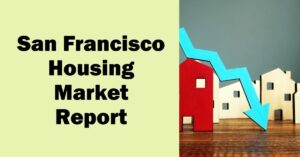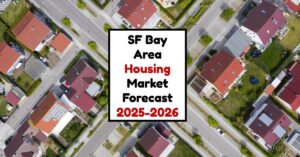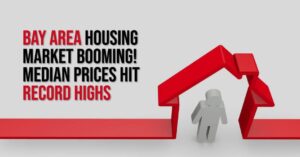The San Francisco housing market is not expected to crash in 2025. While the word “crash” sounds scary, the reality for San Francisco's housing market is far more nuanced. Based on the latest trends and expert forecasts, we're more likely to see continued stability with some ups and downs, rather than a dramatic plunge.
I’ve been following the San Francisco housing market for a while now, and it’s always a hot topic. It’s a place where dreams of homeownership often collide with the Bay Area’s unique economic and social factors. So, when people ask if the market is going to crash, especially in a year like 2025, I understand why. The news can be a little overwhelming with all the talk about interest rates and affordability. But let's break down what’s really happening.
San Francisco Housing Market 2025: Crash Ahead or Steady Growth?
Home Sales
Looking at the data from Redfin, home sales in San Francisco have actually seen a slight increase. In July 2025, 460 homes were sold, which is a little more than the 453 sold in July of the previous year. This indicates a steady demand for homes in the city. While this might not sound like a massive jump, it’s a sign that people are still actively buying property here. The market isn't frozen; it's moving, which is a good sign for stability.
Home Prices
When we talk about home prices in San Francisco, it’s always a big deal. The median sale price of a home in San Francisco was $1.4 million last month. That’s up 1.8% from last year. Now, I know that number might seem sky-high to many, and it is. San Francisco's median sale price is a whopping 195% higher than the national average. This tells us that San Francisco is, and likely will remain, a very expensive place to buy a home.
Are Home Prices Dropping in San Francisco?
So, are home prices dropping? Generally, no. The median sale price is up year-over-year. However, the median sale price per square foot is down 5.9% since last year. This might sound contradictory, but it can happen. It could mean that while overall home prices are holding steady or even slightly increasing, the value per square foot is declining. This might happen if larger homes are selling for less per square foot, or if smaller, more affordable units are seeing less price appreciation compared to the overall market. It’s not a sign of a crash, but rather a subtle shift in what types of homes are selling and at what price points relative to their size.
Housing Supply
The amount of homes available for sale, or “housing supply,” is a crucial factor in market stability. While the provided data doesn't give us exact numbers on inventory, it does mention that homes are selling faster on average this year compared to last year (29 days on market versus 25 days). However, the Redfin data also shows that homes are taking longer to sell on average compared to last year (29 days compared to 25 days). This slight increase in days on market might suggest a subtle increase in available homes, which is generally a good thing for buyers, as it means less intense competition. However, the fact that homes are still selling relatively quickly indicates that demand remains strong.
Is San Francisco a Buyer's Housing Market in 2025?
Right now, San Francisco is described as “very competitive”. Homes sell in about 27 days, and many homes get multiple offers, some even with waived contingencies. The Sale-to-List Price is around 105.4%, meaning homes are generally selling for more than their asking price. About 48.3% of homes are selling above list price.
This data clearly points towards a seller's market. Sellers have the advantage because there are still more buyers than there are homes available. This is especially true for desirable properties. However, the slight increase in days on market and the fact that the sale-to-list price is down slightly (0.41 percentage points year-over-year) might indicate that the market is becoming slightly more balanced. It’s not the frenzied pace of peak boom times, but sellers still hold a strong hand.
Market Trends
Let’s look at the trends. Redfin data from July 2025 shows:
- Median Sale Price: $1.425 million (+1.8% year-over-year)
- # of Homes Sold: 460 (+1.5% year-over-year)
- Median Days on Market: 29 days (+4 days year-over-year)
- Sale-to-List Price: 105.4% (-0.41 pt year-over-year)
- Homes Sold Above List Price: 48.3% (-7.6 pt year-over-year)
What does this tell us? Prices are still going up, but at a slower pace than last year. Homes are selling, but they're taking a few more days to do so. And while most homes still sell for over asking, the percentage of homes selling significantly above list price has decreased. These are signs of a maturing market, not a market on the brink of collapse.
It’s also interesting to see the migration trends. While 24% of San Francisco homebuyers are looking to move out, a much larger portion (76%) want to stay within the metro area. On the flip side, only 3% of homebuyers nationwide are searching to move into San Francisco. This suggests that while some residents might be leaving, the core demand from within the region remains very strong. Popular outbound destinations include Sacramento and Portland, while inbound interest comes from places like Honolulu.
Impact of High Mortgage Rates
Now, let's talk about those mortgage rates. You might have heard a lot about them, and they do have a big impact on the housing market. As of early September 2025, the average 30-year fixed mortgage rate is around 6.5%, and the 15-year fixed rate is about 5.6%.
Here’s the good news: these rates are trending downwards. This is fantastic for buyers because it makes monthly mortgage payments more affordable. Think about it: a lower interest rate means you pay less interest over the life of the loan. This often gives potential buyers the confidence to finally jump into the market. We're even seeing more people refinancing their existing mortgages, which is a sign of a healthy financial environment for homeowners.
Forecasters are predicting that the 30-year fixed mortgage rate will end 2025 somewhere between 6.0% and 6.5%. This continued moderation in rates is expected to keep demand strong and potentially even increase it, especially as the economy continues to grow. While affordability is still a challenge in San Francisco, these lower rates are a significant positive factor for anyone looking to buy.
Here’s a quick look at how mortgage rates can affect affordability. Let's imagine you're buying a $1.4 million home (San Francisco's median price) with a 20% down payment ($280,000), leaving $1.12 million to finance.
| Mortgage Rate | Monthly Principal & Interest (30-yr fixed) |
|---|---|
| 7.0% | ~$7,452 |
| 6.5% | ~$7,079 |
| 6.0% | ~$6,713 |
As you can see, a half-percent difference in interest rates can mean hundreds of dollars less (or more) per month in mortgage payments. This is why the downward trend in rates is so important.
What Does This All Mean for 2025?
Putting all this together, it doesn't paint a picture of a market crash. Instead, it suggests a market that is:
- Resilient: Despite high prices and the lingering effects of interest rate hikes, sales are steady, and prices are still appreciating.
- Moderating: The pace of price growth is slowing down, and homes are taking slightly longer to sell, which can be a healthy sign.
- Influenced by Rates: Lowering mortgage rates are a major positive driver, making buying more accessible for some.
- Still a Seller's Market, but Possibly More Balanced: Sellers still have an edge, but the extreme competition might be easing slightly.
My take on this? San Francisco is unique. Its economy, driven by tech and innovation, creates a constant demand for housing. While external factors like interest rates and broader economic conditions play a role, the fundamental demand in San Francisco is very strong. A “crash” usually happens when there’s a massive oversupply, a severe economic downturn, or a dramatic spike in interest rates that freezes the market. We’re not seeing those conditions for 2025.
Instead, expect a market that continues to be challenging for buyers due to high prices, but one that offers more stability and potentially slightly better conditions than in recent years, especially if mortgage rates continue to fall. It's a market where buyers need to be prepared, but also one where opportunities will exist.
Recommended Read:
- San Francisco Housing Prices Graph
- Average Home Price in San Francisco in 1980
- Homebuyers Are Leaving San Francisco, New York, and Los Angeles
- Top 10 Priciest States to Buy a House by 2030: Expert Predictions
- Bay Area Housing Market: Prices, Trends, Forecast 2024-2025
- Bay Area Housing Market Forecast for Next 2 Years: 2025-2026




